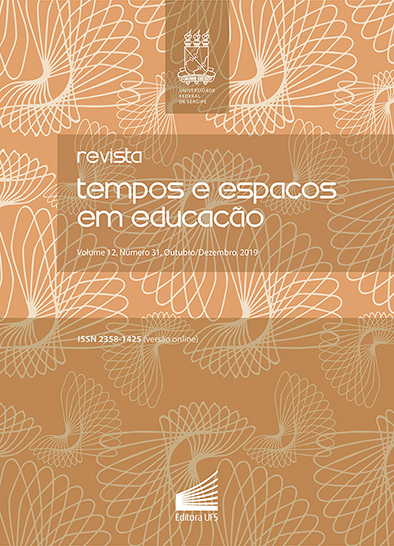STRATEGIES THAT INCREASE THE LEVEL OF LISTENING COMPREHENSION WHILE LISTENING TO ORAL TEXTS
DOI:
https://doi.org/10.20952/revtee.v12i31.11470Abstract
The present paper examines the effectiveness of strategy instructional program elaborated for 120 intermediate students with different previous learning backgrounds attending language center in Saint Petersburg. The objective of the study is to develop program and improve the level of listening comprehension through focusing on potential problems while doing listening tasks. The study either aims at determining and mastering cognitive, metacognitive, social strategies on the part of the students. The authors hypothesize that learners can gain proficiency in using strategies with practice. Strategies can be easily acquired, they facilitate learning, however, number of them are not always transferred to new tasks and used by students as effectively as before when the activity is over. Therefore, systematic strategy instruction component would be important as learners become aware of the learning process and gain the ability to control their own learning through the use of appropriate learning strategies. The authors of the paper have made an attempt to demonstrate that the number of listening comprehension problems reported by the students could be reduced by applying specially designed comprehension activities that assist learners in evaluation of their efforts and assessment of personal achievements. The pilot groups were asked to complete the questionnaires at the beginning and at the end of the course that allowed monitoring the students’ progress throughout the course. At the end of the study, the pilot groups participating in the strategy instructional program were found to be more successful in foreign language comprehension.
Downloads
References
Anderson N.J., 2002. e role of metacognition in second language teaching and learning. Washington, DC:
Center for Applied Linguistics. ERIC Clearing house on Languages and Linguistics.
Anderson, A. & Lynch, T. (1987). Listening. Oxford: Oxford University Press.
Atkinson, R. C. (1975). Mnemotechnics in second-language learning. American Psychologist, 30(8), 821-828.
Barnett, M.A. (1988). Teaching reading strategies: how methodology a ects language course articulation. Foreign Language Annals, 21, 109-119.
Braidi, S. (1998) e acquisition of second language syntax. London: Arnold
Brown, G. (1977) Listening to spoken English. London, New York. Longman.
Brown, G.A. & Yule, G. (1989). Teaching the Spoken Language. Cambridge: Cambridge University Press.
Brown, G.A. (1986). Grading and professionalism in ELT. In P. Meara, P. (Ed.). Spoken Language. (British
Studies in Applied Linguistics). London: Centre for Information on Language Teaching. 3-14.
Brown, G.A., Malmkjaer, M. & Williams, J. (Eds.). (1996). Performance and Competence in Second Language Acquisition. Cambridge: Cambridge University Press.
Berne J.E., 2004. Listening comprehension strategies: A review of the literature. Foreign Language Annals.
:521-534.
Bygate, M. (1987) Speaking. Oxford. OUP.
Cahn, D. D. 1990. Perceived understanding and interpersonal relationships. Journal of Social and Personal
Relationships, 7: 231–244. Doi:10.1177/0265407590072005
Carrier K.A., 2003. Improving high school English language learners’ second language listening through
strategy instruction. Bilingual Research Journal 27(3):383-410.
Chamot A.U., 2005. e Cognitive Academic Language Learning Approach (CALLA): An update. In P.
Richard-Amato & M. Snow (Eds.). Academic success for English language learners (pp. 87-101). White Plains,
Longman, NY.
Chaudron, C. (1988) Second Language Classrooms: Research on Teaching and Learning. Cambridge : Cambridge University Press.
Cole, R. A., & Jakimik, J. (1980) A model of speech perception. In R. A. Cole (Ed.), Perception and production of uent speech. (pp. 133-163). Hillsdale, NJ: Erlbaum.
Dolianac, R.P., 1994. Using motivational factors and learning strategies to predict academic success. Dissertation Abstract International, 56: 1- 142.
Donahue, M., & Parsons, A. H. (1982). e Use of Roleplay to Overcome Cultural Fatigue. TESOL Quarterly,
(3), 359-365.
Ellis, G. and Sinclar, B. (1989) Learnming to learn English. Cambridge. CUP.
Flavell, J.H., 1979. Metacognition and cognitive monitoring: A new area of cognitive developmental inquiry.
American Psychologist, 34: 906-911.
Galskova N. D. (2007) e theory of teaching foreign languages. Moscow: Academy.
Graham D. Bodie, Kellie St. Cyr, Michelle Pence, Michael Rold & James Honeycutt
(2012): Listening Competence in Initial Interactions I: Distinguishing Between What Listening Is and What
Listeners Do, International Journal of Listening, 26:1, 1-28
Graham, S. (2007). Learner strategies and self-e cacy: Making the connection. Language Learning Journal,
(1), 81-93.
Goh, C. (1997) Metacognitive awareness and second language listeners. ELT Journal, 51, pp. 361–9.
Harner, J.( 2008) e practice of English language teaching.4th edition. Pearson.Longman.
Jones, M. N., Kintsch, W., and Mewhort, D. J. K. (2006) High dimensional semantic space accounts of priming. Journal of Memory and Language, 55, pp. 534–52.
Krashen S., 2008. Language education: past, present, and future. Regional Language Centre Journal 39(2):178-
Larsen-Freeman, D. & M.H. Long (1991) An Introduction to Second Language Acquisition Research, Longman.
McGruddy R., 1998. e e ect of listening comprehension strategy training withadvanced level ESL students. Dissertation Abstracts International. 59(12): 4416, (UMI No. 9916234)
Mendelsohn D., 1994. Learning to listen: A strategybased approach for the second-language learner. Dominie Press, San Diego, CA.
Naiman,N., Frohlich,M., Stern,H.H., and Todesco,A., e good language learner. Toronto: Ontario Institute
of Studies in Education, 1978.
Nunan, D. (1989). Language teaching methodology. A textbook for teachers Cambridge. CUP.
Nunan, D. (1991) Language Teaching Methodology. Hemel Hemstead, Herts. : Prentice Hall.
Park G.-P., 2004. Comparison of L2 listening and reading comprehension by university students learning
English in Korea. Foreign Language Annals. 37: 448-459.
Pavio, A., & Desrochers, A. (1979). E ects of an imagery mnemonic on second language recall and comprehension.Canadian Journal of Psychology, 33, 17–28.
Polat, E.S. (2000), “Method of projects at lessons of a foreign language”, Foreign languages at school, No. 2,
pp. 4-10.
Pressley, M., Levin, J. R., & Delaney, H. D. (1982). e mnemonic keyword method. Review of Educational
Research, 52(1), 61-91. doi: 10.2307/1170273.
Royce, T. 2005. e negotiator and the bomber: Analyzing the critical role of active listening in crisis negotiations. Negotiation Journal, 21: 5–27.
Downloads
Published
How to Cite
Issue
Section
License
À Revista Tempos e Espaços em Educação ficam reservados os direitos autorais pertinentes a todos os artigos nela publicados. A Revista Tempos e Espaços em Educação utiliza a licença https://creativecommons.org/licenses/by/4.0/ (CC BY), que permite o compartilhamento do artigo com o reconhecimento da autoria.



